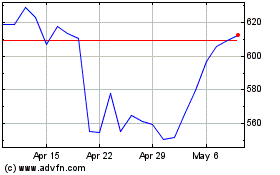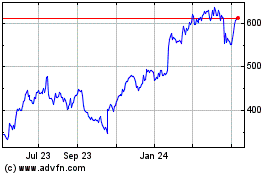Netflix Faces New Test as Economies Reopen
April 20 2021 - 5:59AM
Dow Jones News
By Micah Maidenberg
Netflix Inc.'s subscriptions soared last year as the Covid-19
pandemic curtailed big parts of economies globally. The company
must now contend with people looking to leave the house more and a
growing number of competitors.
Netflix's subscriber base jumped by roughly 37 million on a net
basis during 2020 to reach 204 million by the end of December, a
performance that further cemented its powerful status in the
content-streaming market. Executives at the Los Gatos, Calif.,
company have said the pandemic pulled forward demand because
alternative entertainment options dried up.
"There's a boost in engagement that you get when people are in a
lockdown situation," Netflix operations chief Gregory Peters said
at an investor event last month.
Many consumers who get vaccinated are venturing out of their
homes more and shifting spending despite the lingering threat posed
by coronavirus. Airlines are looking for a resurgence in summer
travel. Movie theaters and other venues have reopened in New York,
Los Angeles and elsewhere. Restaurants and hotels, both hard hit by
pandemic-related closures and restrictions, have stepped up
hiring.
For the first quarter, Netflix has said it expects to add six
million new subscribers, less than half of the 15.8 million it
gained for the year-earlier period, when the spread of the
coronavirus was first intensifying. The company also forecast $1.36
billion in net income on $7.13 billion in revenue for the
period.
Netflix made a number of changes last year amid the surge in new
subscribers. The company said in July that it promoted Ted Sarandos
to co-chief executive, a position he holds along with Reed
Hastings. In October, Netflix boosted the monthly price of its most
popular streaming plan by $1 to $13.99 a month, and its premium
offering by $2 to $17.99 a month.
Netflix increased the prices as other media companies have
expanded their own streaming platforms, often working to draw in
users with lower monthly rates. Newer services include Walt Disney
Co.'s Disney+, Apple Inc.'s Apple TV+ and AT&T Inc.'s HBO Max.
Discovery Inc. launched Discovery+ in the U.S. in January.
ViacomCBS Inc. debuted the Paramount+ service in the domestic
market last month.
Many competing streaming services "are priced at a discount to
Netflix," analysts at Raymond James said in flagging the company's
increase as a potential risk for subscriber retention.
In January, Netflix said it had been expecting more competition,
and that was why the company had been building up its portfolio of
original shows that appeal to a broad set of consumers world-wide.
The company has been working to secure rights to content from other
studios too, recently signing a deal with Sony Pictures
Entertainment for domestic streaming rights to its theatrical
movies.
Some analysts have said Netflix's command on consumers has
slipped recently and forecast slower growth ahead. The company
controlled half of demand for original content globally in the
first quarter, down from 54% for all of last year, according to
Parrot Analytics, which measures streaming.
EMarketer expects the average amount of time consumers in the
U.S. will spend each day using Netflix will rise 3% this year over
2020. Between last year and 2019, consumer usage jumped 20% to more
than 31 minutes a day, according to the firm.
Some Netflix subscribers may notice other changes to their
service. Last month, the company began experimenting with greater
password enforcement to prevent users from sharing their
accounts.
Write to Micah Maidenberg at micah.maidenberg@wsj.com
(END) Dow Jones Newswires
April 20, 2021 05:44 ET (09:44 GMT)
Copyright (c) 2021 Dow Jones & Company, Inc.
Netflix (NASDAQ:NFLX)
Historical Stock Chart
From Mar 2024 to Apr 2024

Netflix (NASDAQ:NFLX)
Historical Stock Chart
From Apr 2023 to Apr 2024
